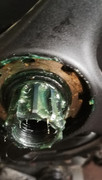E&NonEinCO
Member
Symptom: When pedaling backwards, the chainring also moved backwards. While moving and then stopping pedaling, initially there is some resistance felt in the crankarms. The bike has only 2k miles and it's mostly ridden in snow - minimal wet conditions.
Problem: The non drive side needle bearings were completely seized due to water ingress. Bearings are a common failure on these motors as a result of water entering between the spindle and its housing.
Solution: Seal the gap between the spindle and its housing.
Drive side - Remove crank arm and place a rubber o-ring over the spindle. Insure you don't pinch the o-ring when reinstalling the crank arm. The o-ring should be between the spindle housing and the crank arm.
Non drive side - Remove the motor cover and crank arm; cut a piece of bicycle inner tube (thicker vs thinner); roughly 43mm diameter; cut a 24mm diameter hole in the center for the spindle (the hole should be slightly smaller than the spindle diameter to insure a good seal); use thin two-sided tape to adhere the rubber to the motor housing. Reinstall motor cover and crank arm.
If you have one of these motors, the explanation above will be obvious.
Before installing my spare S motor (S and T motors have the same form factor), I disassembled the bad T motor to find the bad needle bearings. I then added the above seals to the new motor.
Problem: The non drive side needle bearings were completely seized due to water ingress. Bearings are a common failure on these motors as a result of water entering between the spindle and its housing.
Solution: Seal the gap between the spindle and its housing.
Drive side - Remove crank arm and place a rubber o-ring over the spindle. Insure you don't pinch the o-ring when reinstalling the crank arm. The o-ring should be between the spindle housing and the crank arm.
Non drive side - Remove the motor cover and crank arm; cut a piece of bicycle inner tube (thicker vs thinner); roughly 43mm diameter; cut a 24mm diameter hole in the center for the spindle (the hole should be slightly smaller than the spindle diameter to insure a good seal); use thin two-sided tape to adhere the rubber to the motor housing. Reinstall motor cover and crank arm.
If you have one of these motors, the explanation above will be obvious.
Before installing my spare S motor (S and T motors have the same form factor), I disassembled the bad T motor to find the bad needle bearings. I then added the above seals to the new motor.









